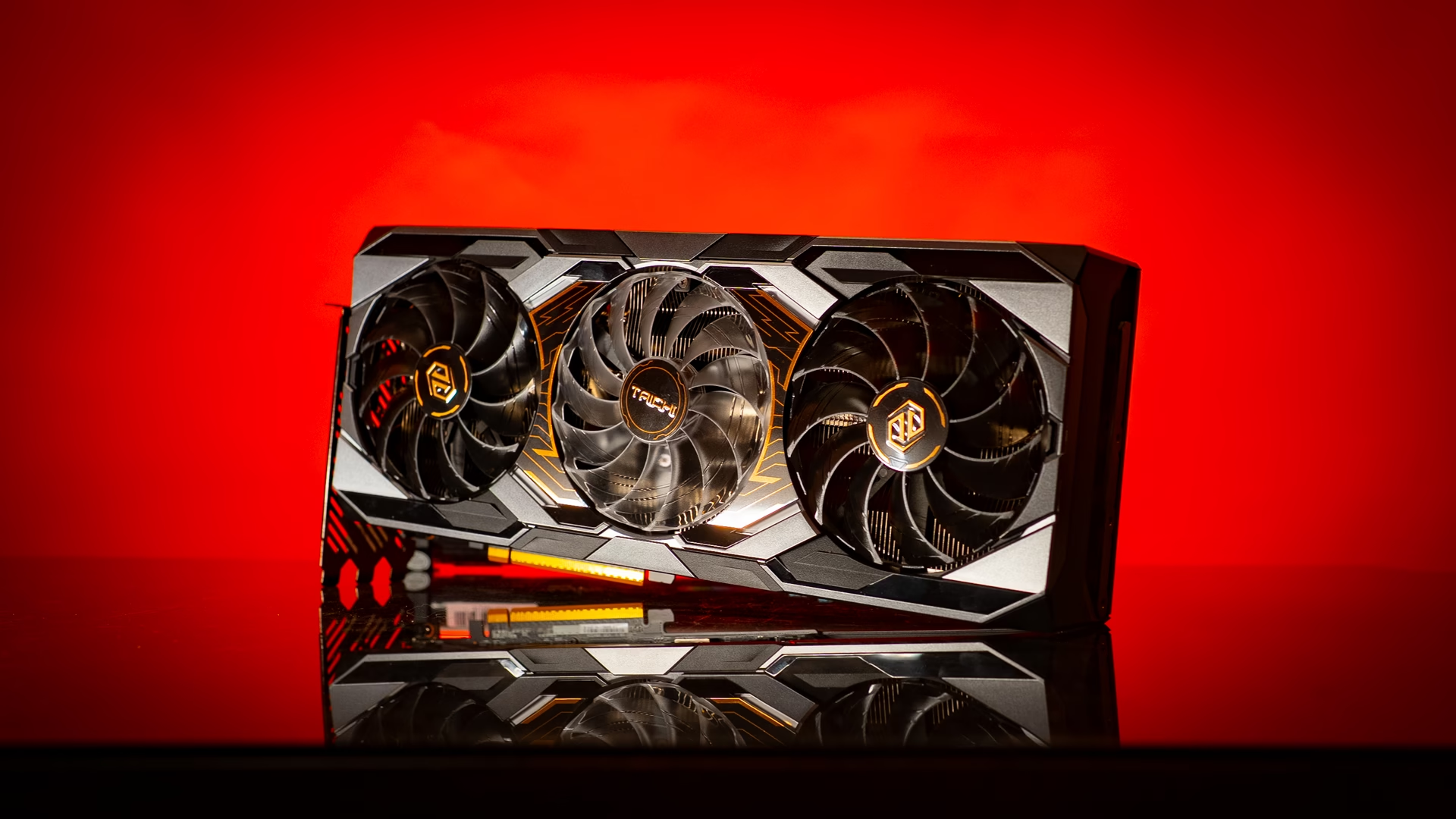These last few years, my attitude towards AMD Radeon graphics cards can be adequately summarised by the meme below. Nvidia’s been riding roughshod over the PC gaming community for some years now, and they’ve only been able to do so for one simple reason: Until the 9070 XT, AMD had nothing that could adequately compete with Nvidia’s overpriced RTX GPUs.
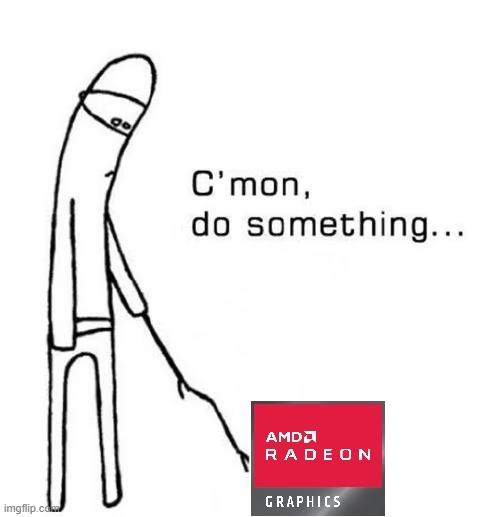
Until the 9070 XT, AMD’s performance in the ray-tracing department has been so bad that a two years older RTX 3080 with less than half the VRAM manages to outperform AMD’s flagship Radeon RX 7900 XTX in certain ray-traced benchmarks. Add to this the widening quality gulf between AMD’s FSR and Nvidia’s DLSS upscalers, and you’re starting to see why these last few years have been immensely frustrating for us PC gamers.
Until the 9070 XT, our choices had been limited to either paying a stupidly high premium for Nvidia VRAM-limited GPUs for the sake of ray-tracing and tolerable raster performance, or to side with AMD and convince oneself that ray-tracing was overhyped and that raster would do for the foreseeable future. If Steam’s hardware survey is any indication — and it usually is — the vast majority of gamers (83.07%) chose the former.
What is the 9070 XT?
The AMD Radeon RX 9070 XT is the first of a new generation of GPU from AMD. It’s not a flagship (but given its performance could easily be considered one) but rather a mid-range GPU that’s expected to retail at around Rs 70,000 ($599 in the US, plus taxes and other duties applicable to India). Unlike Nvidia’s RTX 5000 series cards, AMD expects that there will be plenty of stock for all, and that units will sell at around MSRP.
The card is based on an entirely new architecture — RDNA 4 — features 16 GB of VRAM, and is expected to match or surpass Nvidia’s RTX 5070 Ti. When it’s in stock the 5070 Ti is retailing at Rs 1,00,000+ (at least 30% over MSRP).
| Model | RX 9070 | RX 9070 XT |
|---|---|---|
| RDNA 4 CUs | 56 | 64 |
| HW RT Accelerators | 56 | 64 |
| HW AI Accelerators | 112 | 128 |
| Peak AI TOPS | 1165 | 1557 |
| Boost Clock (GHz) | 2.52 | 2.97 |
| VRAM (GB) | 16 | 16 |
| TGP (W) | 220 | 304 |
| Interface | PCIe 5 x16 | PCIe 5 x16 |
RDNA 4 for the win
AMD’s RDNA 4 architecture isn’t just an evolutionary upgrade over the previous RDNA 3 architecture. It’s a ground-up redesign that precisely targets and fixes the two key issues plaguing AMD GPUs: ray-tracing performance and the quality of FSR upscaling.
You’ll find a deeper dive into RDNA 4 here and my thoughts on FSR here, suffice it to say that the ray-tracing pipeline has been completely overhauled to deliver around 2x the ray-tracing performance per CU (Compute Unit, which, in an AMD GPU, is somewhat analogous to a CPU core).
On top of that, AMD’s FSR upscaling tech is now powered by AI. This means upscaling is now faster, more efficient, and delivers better quality images. AMD didn’t harp on this as much as Nvidia did, but RDNA 4 also supports flip metering, a technology that allows the CPU and GPU to better synchronise their actions and reduce PC latency.
Sadly, and unlike DLSS 4 and older Nvidia RTX GPUs, FSR 4 is not coming to older Radeon GPUs.
To put it simply, GPUs are designed to perform certain kinds of math operations very quickly, and the kind of math the 9000 series performs for FSR 4’s AI model is very different from the kind of maths the 6000 and 7000 series GPUs can perform.
Productivity performance
I could not get my hands on a 5070 or 5070 Ti in time for this review so I’ll limit comparisons to AMD’s current flagship GPU, the AMD Radeon RX 7900 XTX.
When it comes to general productivity, photo editing, and video editing, the the 7900 XTX is faster by about 10-20%. I expected video editing performance to be better on the 9070 XT, but I guess AMD focused on improving the quality of video encoding rather than the speed.
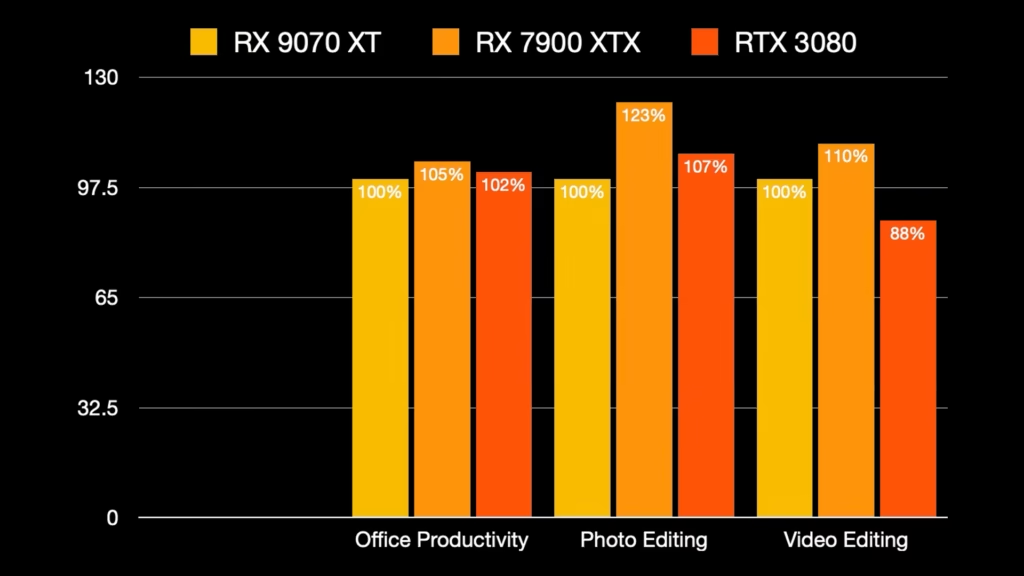
In AI benchmarks as measured by UL Benchmark’s Procyon test suite, the 7900 XTX is ahead by about 10%. Again, I expected the 9070 XT to be faster here (the much older RTX 3080 is 50% faster than both cards thanks to TensorRT), but I suppose AMD still has to work on optimisations for its new GPU architecture.
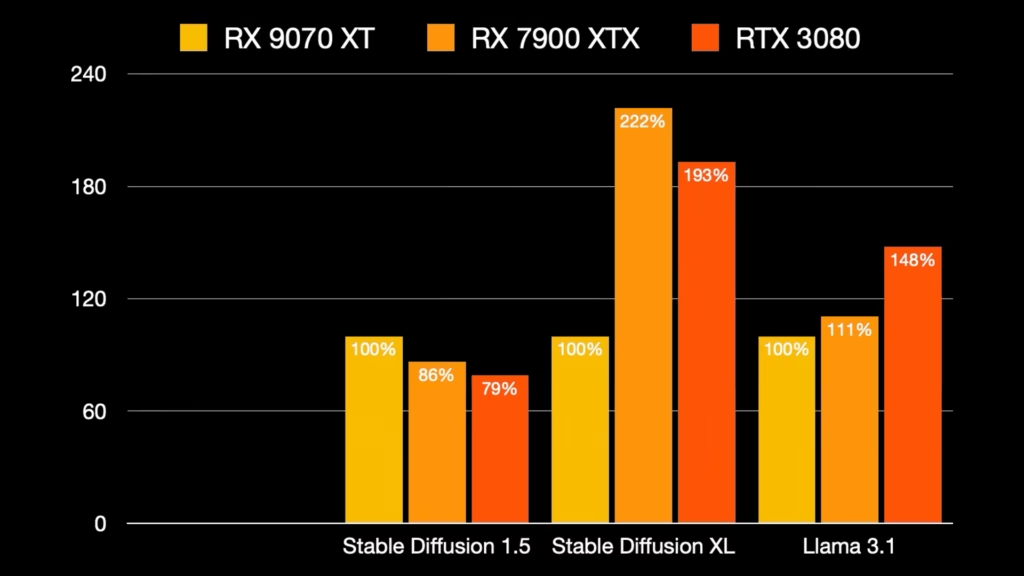
Raster performance: It’s 2-6% slower
Coming to gaming, we’ll first look at raster performance at 2K (2560×1440) at each game’s high or maximum setting without ray-tracing or upscaling.
Counter-Strike 2 aside, the 9070 XT performs at par with the more expensive, theoretically more powerful 7900 XTX. It’s only in CS 2 that the 7900 XTX takes a big lead, but both cards are delivering well over 350 FPS so the difference is moot from a gamer’s perspective. The geomean between the two cards at 2K is just 2.3%.
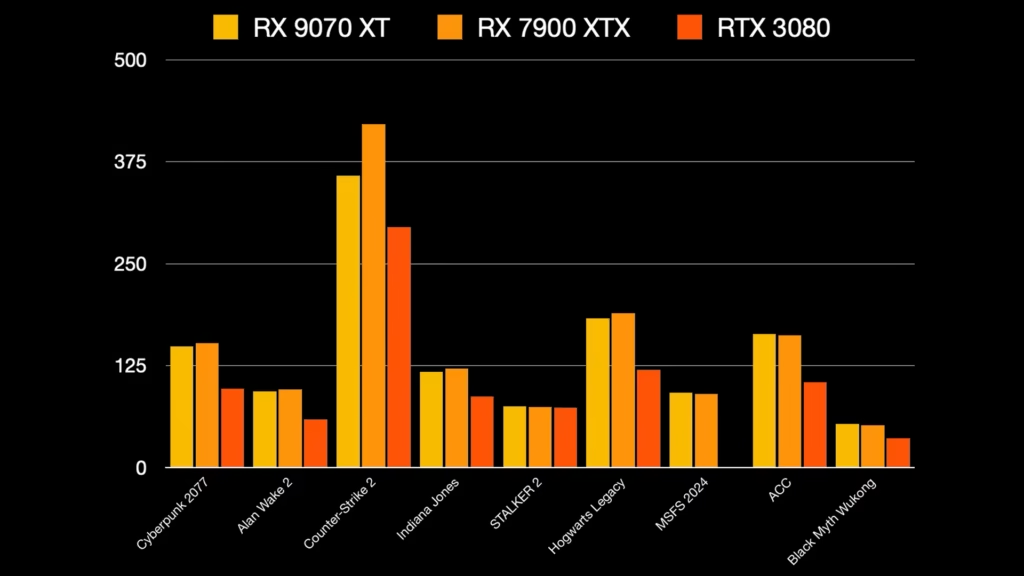
At 4K (3840×2160) and the same settings, the 7900 XTX pulls slightly ahead (by 6%), thanks to a 23-25% lead in both Counter-Strike 2 and Assetto Corsa Competicizione. In most cases, the 9070 XT is delivering 50-60 FPS or more without any form of AI fakery.
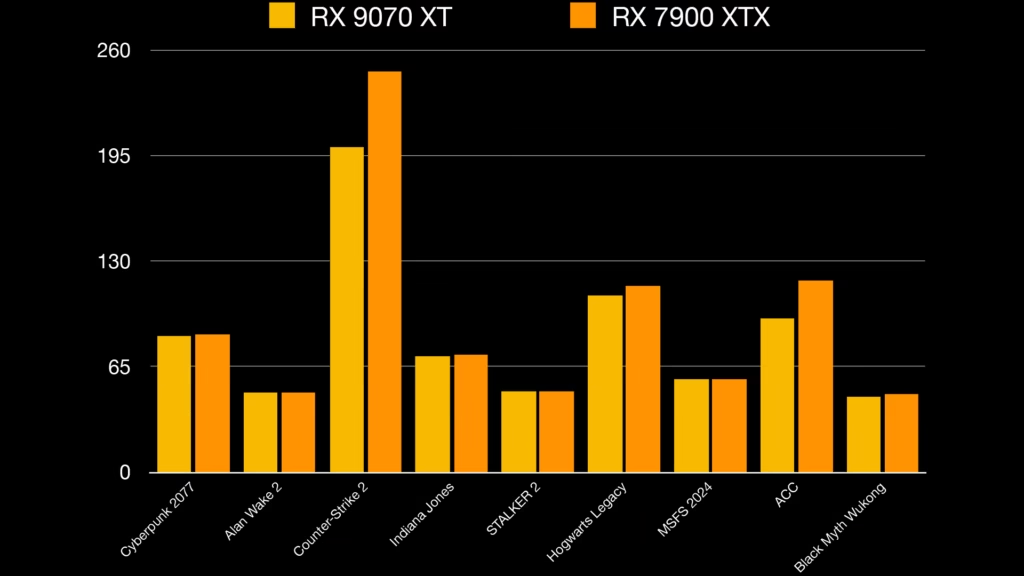
RT performance: 15-24% faster
Now this is where the RX 9070 XT truly flexes its muscle. As mentioned earlier, each CU of the RDNA 4 architecture delivers roughly twice the RT performance that each RDNA 3 CU did. This means that the 9070 XT, despite having 20 fewer CUs than the flagship 7900 XTX, can theoretically deliver better RT performance. The benchmarks bear this out.
At 2K with ray-tracing set to medium or high as relevant, the 9070 XT is 24% faster than the 7900 XTX. The biggest lead is seen in Alan Wake 2, where the 9070 XT is 60% faster, and second in Hogwarts Legacy, where the 9070 XT is 36% faster.
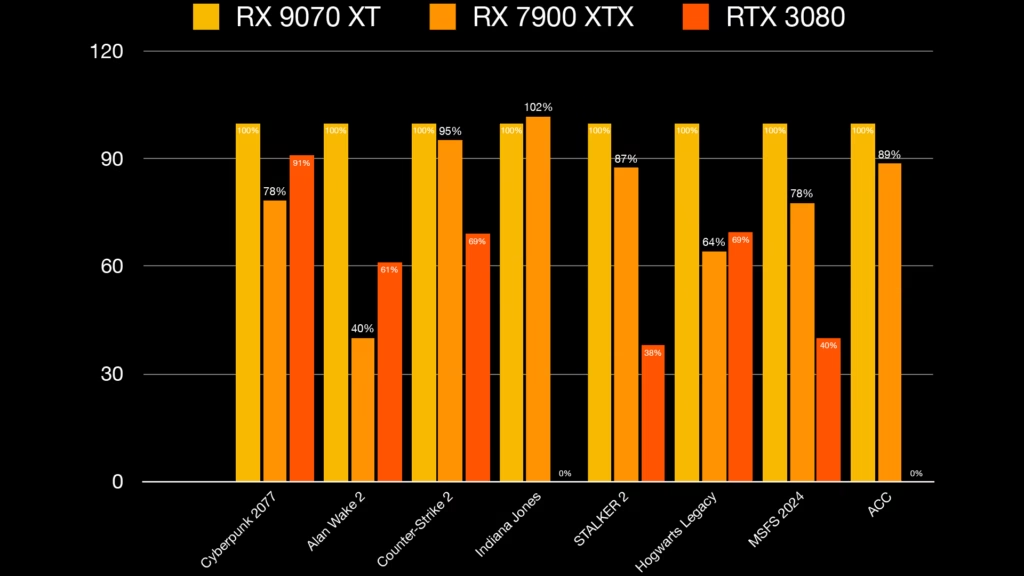
At 4K with FSR enabled where necessary, the 9070 XT’s lead decreases to 15%, but again, we’re looking at a reasonably priced, mid-range GPU outperforming an expensive flagship.
Thoughts on FSR
As expected, the only let-down here is FSR. FSR is needed at both 2K and 4K to get to that magical 60 FPS target when using ray-tracing. At 2K, you can get away with dropping to FSR Quality mode (which looks great), but at 4K, you will likely need to drop to FSR Performance upscaling. Unfortunately, Performance upscaling based on FSR 2 is unusable at 4K. It’s possible to enable FSR 4 for a much cleaner output in the handful of titles that support FSR 3.1, but these are very few at the time of writing.
As with DLSS 4 and Nvidia cards, the true power of the 9070 XT will only be revealed in the coming months as more games add support for FSR 4 and FSR 4 performance mode becomes more usable.
Bottom line: The best mid-range GPU of this generation
AMD has finally done it! They’ve finally delivered a GPU that not only delivers that generational uplift any reasonable gamer would expect, but also gives Nvidia a run for its money thanks to feature parity and a potential performance lead.
If AMD can, as promised, deliver this GPU into the hands of gamers at MSRP, we’re looking at the best mid-range GPU of this generation. The Steam Hardware survey is going to look distinctly redder in the coming months (I hope).
Good work, AMD. Now go make a flagship.
